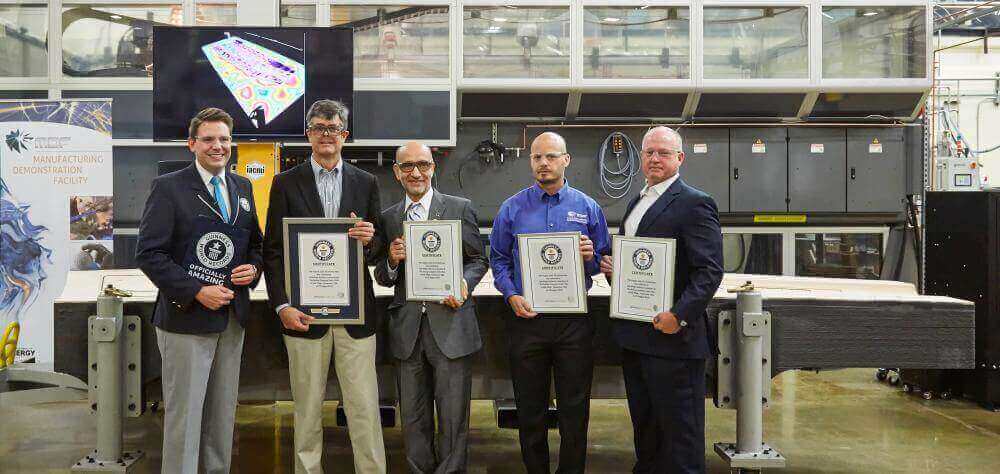The Guinness Book of World Records has certified the world’s largest 3D printed object, made by the Oak Ridge National Laboratory in the USA.
If you’re an Aerospace company like Boeing and you want to build a big airplane, you’re going to need special tools for the job. That’s where 3D printing begins to prove its worth.
Researchers at Oak Ridge National Lab have developed a 3D printed version of a “trim-and-drill” tool that Boeing uses to build the wings on its passenger aircraft. It took 30 hours to print using carbon fiber and composite plastic materials.
The finished item is about the size of a typical Suburban Utility Vehicle (SUV), weighs 1,650 lbs, and measures 17.5 feet long, 5.5 feet wide and 1.5 feet tall. All of which makes it offically the world’s largest solid object made with a 3D printer.
During an awards ceremony held at the Department of Energy’s Manufacturing Demonstration Facility at ORNL — where the component was 3D printed on the lab’s Big Area Additive Manufacturing machine — Guinness World Records judge Michael Empric measured the trim tool in person. After he was satisfied it exceeded the required minimum of 0.3 cubic meters, or approximately 10.6 cubic feet, he announced the new record title.
Vlastimil Kunc, leader of ORNL’s polymer materials development team, said:
“The recognition by Guinness World Records draws attention to the advances we’re making in large-scale additive manufacturing composites research. Using 3D printing, we could design the tool with less material and without compromising its function.”
World’s Largest 3D Printed Object… For Now
Using 3D printing has made the final product cheaper and quicker to manufacture, and will save energy, time and money for Boeing. Most importantly, it works just as well as the conventional metal version. The company will begin using the tool in 2017 for the production of its 777X passenger jet in St. Louis.
Leo Christodoulou, Boeing’s director of structures and materials, said:
“The existing, more expensive metallic tooling option we currently use comes from a supplier and typically takes three months to manufacture using conventional techniques. Additively manufactured tools, such as the 777X wing trim tool, will save energy, time, labor and production cost and are part of our overall strategy to apply 3D printing technology in key production areas.”
Meanwhile, ORNL remains at the forefront of advanced additive manufacturing; at their Manufacturing Demonstration Facility, they’ve been exploring the potential for new methods like 3D printing and new materials like advanced composites.
In addition to the tool for Boeing, the same facility 3D printed a Shelby Cobra sports car, a house/car energy system, and an Army Jeep. They’re also experimenting with 3D printed molds for wind turbine blades, which would drastically cut down manufacturing time for turbine blades and make it easier to test out new designs.
All in all, it makes a great deal of sense for the Energy Department to invest in manufacturing technologies. Building lighter products in less time has the potential for huge energy savings. And when it’s quicker and cheaper to build things, the pace of innovation accelerates as well.
That record for the world’s largest 3D printed object may yet be broken in the not-too-distant future…
Source: Press Release

License: The text of "This is The World’s Largest 3D Printed Object" by All3DP is licensed under a Creative Commons Attribution 4.0 International License.